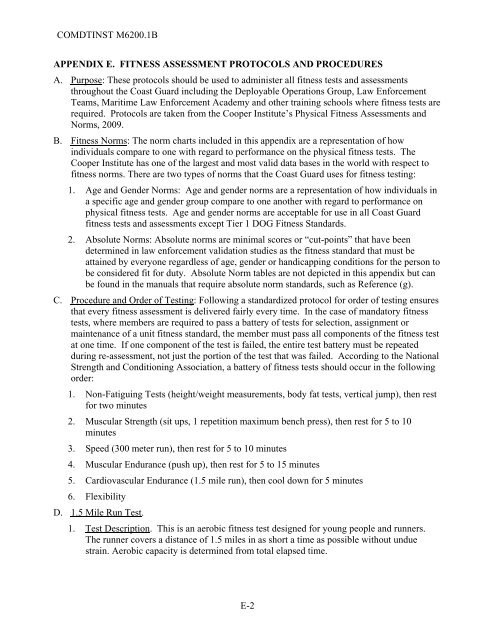Monthly Fitness Test Requirements - U.S. Coast Guard
Monthly Fitness Test Requirements - U.S. Coast Guard
Monthly Fitness Test Requirements - U.S. Coast Guard
Create successful ePaper yourself
Turn your PDF publications into a flip-book with our unique Google optimized e-Paper software.
COMDTINST M6200.1B<br />
APPENDIX E. FITNESS ASSESSMENT PROTOCOLS AND PROCEDURES<br />
A. Purpose: These protocols should be used to administer all fitness tests and assessments<br />
throughout the <strong>Coast</strong> <strong>Guard</strong> including the Deployable Operations Group, Law Enforcement<br />
Teams, Maritime Law Enforcement Academy and other training schools where fitness tests are<br />
required. Protocols are taken from the Cooper Institute’s Physical <strong>Fitness</strong> Assessments and<br />
Norms, 2009.<br />
B. <strong>Fitness</strong> Norms: The norm charts included in this appendix are a representation of how<br />
individuals compare to one with regard to performance on the physical fitness tests. The<br />
Cooper Institute has one of the largest and most valid data bases in the world with respect to<br />
fitness norms. There are two types of norms that the <strong>Coast</strong> <strong>Guard</strong> uses for fitness testing:<br />
1. Age and Gender Norms: Age and gender norms are a representation of how individuals in<br />
a specific age and gender group compare to one another with regard to performance on<br />
physical fitness tests. Age and gender norms are acceptable for use in all <strong>Coast</strong> <strong>Guard</strong><br />
fitness tests and assessments except Tier 1 DOG <strong>Fitness</strong> Standards.<br />
2. Absolute Norms: Absolute norms are minimal scores or “cut-points” that have been<br />
determined in law enforcement validation studies as the fitness standard that must be<br />
attained by everyone regardless of age, gender or handicapping conditions for the person to<br />
be considered fit for duty. Absolute Norm tables are not depicted in this appendix but can<br />
be found in the manuals that require absolute norm standards, such as Reference (g).<br />
C. Procedure and Order of <strong>Test</strong>ing: Following a standardized protocol for order of testing ensures<br />
that every fitness assessment is delivered fairly every time. In the case of mandatory fitness<br />
tests, where members are required to pass a battery of tests for selection, assignment or<br />
maintenance of a unit fitness standard, the member must pass all components of the fitness test<br />
at one time. If one component of the test is failed, the entire test battery must be repeated<br />
during re-assessment, not just the portion of the test that was failed. According to the National<br />
Strength and Conditioning Association, a battery of fitness tests should occur in the following<br />
order:<br />
1. Non-Fatiguing <strong>Test</strong>s (height/weight measurements, body fat tests, vertical jump), then rest<br />
for two minutes<br />
2. Muscular Strength (sit ups, 1 repetition maximum bench press), then rest for 5 to 10<br />
minutes<br />
3. Speed (300 meter run), then rest for 5 to 10 minutes<br />
4. Muscular Endurance (push up), then rest for 5 to 15 minutes<br />
5. Cardiovascular Endurance (1.5 mile run), then cool down for 5 minutes<br />
6. Flexibility<br />
D. 1.5 Mile Run <strong>Test</strong>.<br />
1. <strong>Test</strong> Description. This is an aerobic fitness test designed for young people and runners.<br />
The runner covers a distance of 1.5 miles in as short a time as possible without undue<br />
strain. Aerobic capacity is determined from total elapsed time.<br />
E-2
















